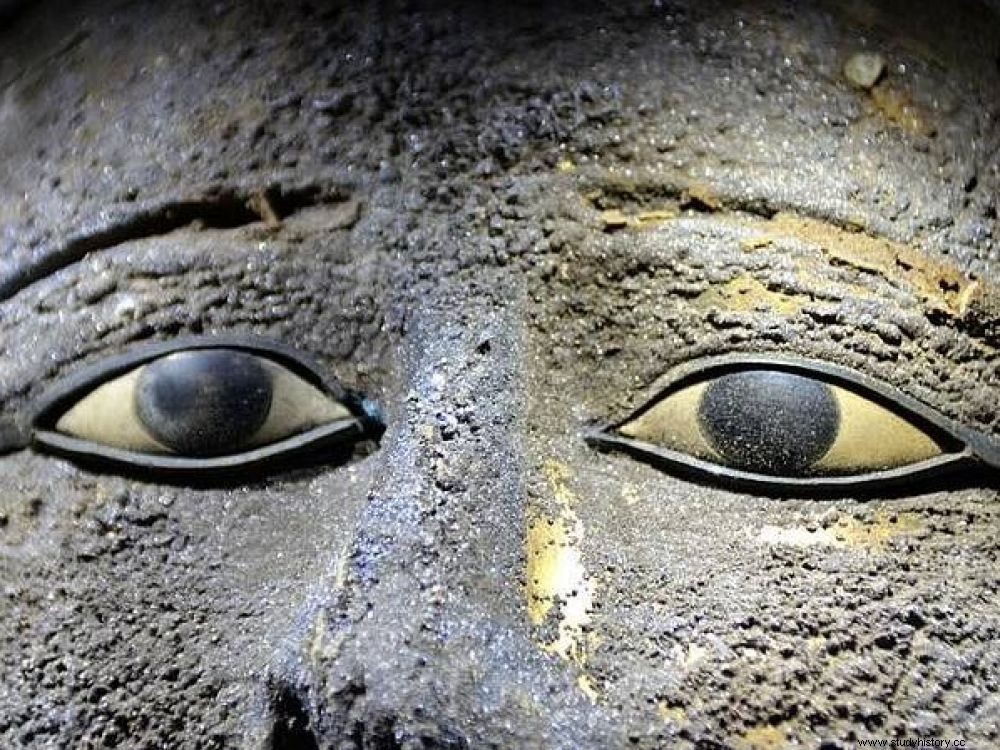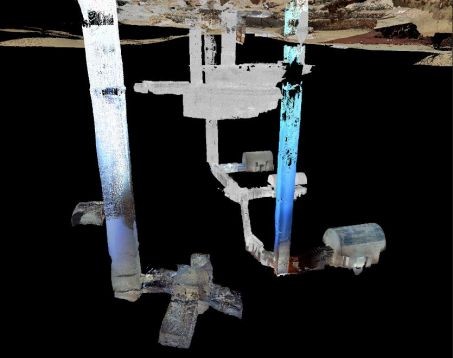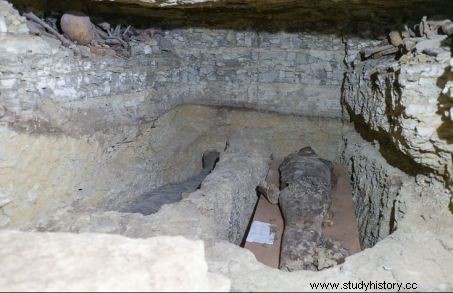A silver-gilt mask and a rare mummification workshop unearthed in the necropolis of Saqqara, Egypt.

Rare silver-gilt mask with eyes encrusted with calcite and obsidian unearthed in an underground burial chamber.
Thirty-five mummies, five sarcophagi, a gilded silver mask - the first found since 1939 - and above all a complete mummification workshop... Between the national celebrations of July 14, 2018 and the final of the football world cup won by the he French team, it was very difficult this weekend to attract attention. However, Egypt was able to recall how much its basement continued to deliver unheard-of treasures.
It was on the Giza plateau, in the vast necropolis of Saqqara, south of Cairo, not far from the pyramid of Unas, that these remains were unearthed. The announcement was made by Egyptian Antiquities Minister Khaled El-Anany, who at an international press conference detailed the discovery of burial chambers and a mummification workshop dating back to the XXVI Dynasty, or Saite period (664-525 BC), brief century of rebirth of pharaonic Egypt before the Persian conquest (525 BC). It was an Egyptian-German research team, led by Ramadan Badry Hussein, who spotted these remains in the depths of wells dug up to 30 meters deep more than 2,500 years ago.
 3D photogrammetric models of underground conduits and burial chambers from the Saite period discovered at Saqqara. Credits:University of Tübingen.
3D photogrammetric models of underground conduits and burial chambers from the Saite period discovered at Saqqara. Credits:University of Tübingen.
Several mummies, wooden coffins and stone sarcophagi - still intact and sealed for four of them - were arranged along corridors carved into the rock where there were also significant quantities of ouchebtis (or chaouabtis ) in faience, these "small funerary servants" placed in quantity in the tombs. It was there, underground, that she also unearthed a rare embalming workshop, in a second conduit, a 13-meter vertical chimney. It is in this place that the bodies of the deceased were conditioned for their journey of eternity.
 Stone sarcophagus with mummy inside. Credits:Ministry of Egyptian Antiquities
Stone sarcophagus with mummy inside. Credits:Ministry of Egyptian Antiquities
 Ushebtis, faience figurines discovered in quantity. Credits:Ministry of Egyptian Antiquities
Ushebtis, faience figurines discovered in quantity. Credits:Ministry of Egyptian Antiquities
Alabaster canopic jars intended to receive their viscera were also found, as well as a series of containers with the engraved names of the ointments and substances used in the mummification process, a prelude to the laying of the linen bandages ( read sidebar ). “The discovery of these residual oils is a veritable goldmine! It will make possible the precise determination of their chemical composition », rejoices Ramadan Badry Hussein, Egyptologist at the University of Tübingen (Germany). Two large basins with raw earth walls could also have contained natron (natural salts) in which the remains were immersed to dehydrate them. In an adjoining burial chamber, a silver-gilt mask with eyes encrusted with calcite and obsidian still covered the face of a mummy lying in a badly damaged wooden vat.
 Golden silver mask, before restoration. Credits:Ramadan Badry Hussein / University of Tübingen
Golden silver mask, before restoration. Credits:Ramadan Badry Hussein / University of Tübingen
Early studies have shown that it may have belonged to a "second priest of Mut", the vulture-capped deity. The embalmers were indeed priests, because mummification was associated with a religious ritual, the Egyptians thinking that death was only a stage. The name of the mask's owner also includes the name of the goddess Neith, whose cult culminated in the XXVIth Saite Dynasty. Very darkened by more than two millennia spent underground, this mask will undergo an intense restoration.
3D renderings made from laser surveys carried out by the eScience Center directed by Matthias Lang at the University of Tübingen (Germany) now make it possible to visualize this underground complex studied since 2016, as part of the "Project of the Saïte Tombs of Saqqara". A sector which the Frenchman Gaston Maspero (1846-1916), who worked on site, had apparently not spotted the entrance to at the end of the 19th century. "This is just the beginning of the discoveries “warned the Minister. All unearthed objects will be exhibited in the Grand Egyptian Museum (GEM), currently in the completion phase.
 Canopic jars containing the viscera of the deceased. Credits:Ministry of Egyptian Antiquities
Canopic jars containing the viscera of the deceased. Credits:Ministry of Egyptian Antiquities
- Mummification:3000 years of experience
Over the three millennia in which they have been practiced, mummification techniques have fluctuated greatly. The principle was to avoid the putrefaction of the corpses. Once washed, the bodies of the deceased underwent an extraction of the brain (excerebration), stomach, liver, lungs and intestines (evisceration). Embalmed, the viscera were then slipped into four canopic jars. Only the heart, seat of life, remained in its place in the body.
 Some of the mummies found at the bottom of the burial pits. Credits:Ministry of Egyptian Antiquities
Some of the mummies found at the bottom of the burial pits. Credits:Ministry of Egyptian Antiquities
Wrapped in natron (sodium carbonate), the flesh was dried during a 40-day maceration. They were then covered with several layers of overlapping strips of linen impregnated with odoriferous materials and perfumed ointments. Protective amulets were inserted among the bandages and then a funerary mask placed on the face. The whole process required 70 days. The Egyptologist Pascal Vernus, from the Ecole Pratique des Hautes Etudes, recalls that because of "the ungratifying smell that escaped from the fish saltings, the same Greek word 'taricheute' designated the specialist in embalming and salting! .
